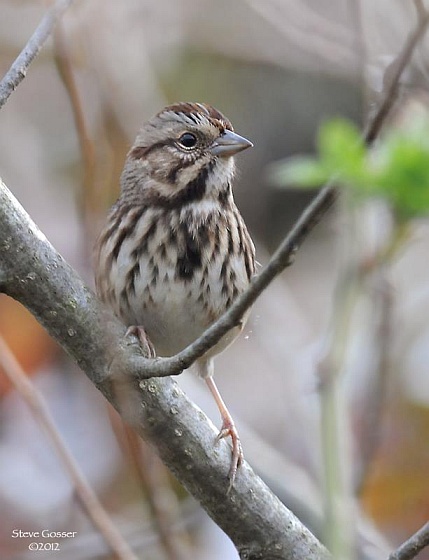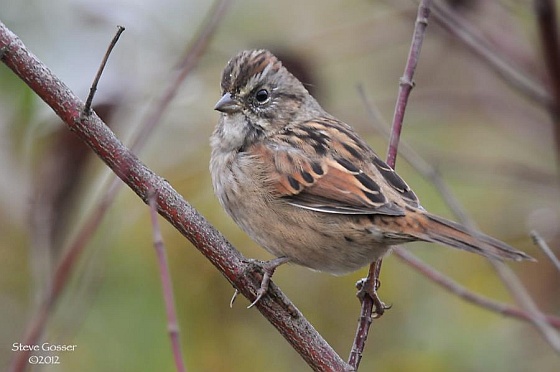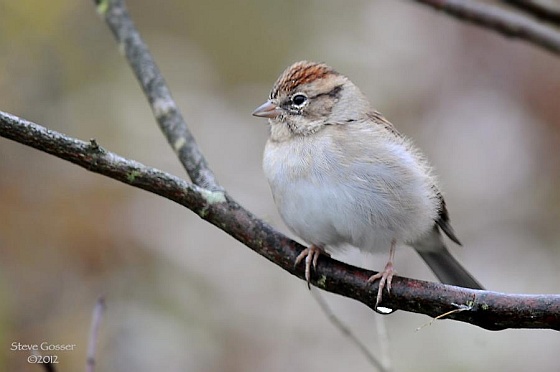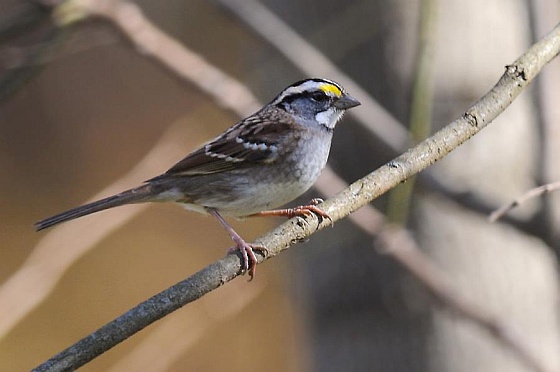
The warblers are gone. The sparrows are here.
These little brown birds can pose an identification problem because they look so similar. When they tried to fool me last Sunday I decided to write about them. Here are four species you’re likely to find in western Pennsylvania in October with some tips on telling them apart.
Shown above is a song sparrow, a common bird that stays here all year. His color varies regionally across the U.S. but in Pennsylvania he’s brown. His field marks are his long tail, a striped face with pronounced malar stripes, and brown streaks on his white breast that form a blotch in the middle.
Get to know the song sparrow really well and you’ll have a basis for comparing other sparrows.
And here’s the first sparrow to compare…

Swamp sparrows are the same size and shape as song sparrows but their tails are shorter. Though their chestnut colored wings are a good field mark, don’t look hard for color clues on swamp sparrows. The very best tip is this: Swamp sparrows look dark. If you’re in the right habitat and are telling yourself, “This sparrow looks dark. It must be a trick of the light,” think again! Swamp sparrow.
Swamp sparrows are very picky about habitat and are normally found near water, especially in wetlands. And they don’t stay here all year. They breed in western Pennsylvania but are leaving now for points south.
The third sparrow looks different than a song sparrow… from the front.

The chipping sparrow is slightly smaller than a song sparrow and much whiter overall because he has a clear white chest. Like the swamp sparrow he breeds here in summer and leaves for the winter. Summer adults have sharp rusty caps and black eyestripes set off by their white faces. In the fall their rusty caps and black eyestripes fade and their formerly white faces develop tan ear patches. The tan face resembles the clay-colored sparrow’s except that chipping sparrows don’t have an outline around the patch. Another clue: Chipping sparrows are common in western Pennsylvania, clay-colored sparrows are not.

And finally, this white-throated sparrow has just arrived from Canada to spend the winter here. He looks very crisp with white head stripes, yellow lores and a white throat with a sharp dark border to set it off. But beware, there are two color morphs of white-throated sparrows: white and tan. The tan morph is tan on the head and back where this one is white. White-throats keep these two colors in the gene pool by preferring to breed with a bird of another color.
Good luck practicing with sparrows. These “Little Brown Jobs” make it even more challenging by hiding in the weeds.
(photos by Steve Gosser)
Thanks for the identification tips, Kate. I love the song sparrows, especially the song. Yesterday, one was chirping merrily as it splashed around in the bird bath in my yard. It didn’t miss a beat as I stepped outside and sat down to watch.
Excellent, Kate. Sparrows are the most plentiful birds around my apartment (besides pigeons) and I’ve always had difficulties in telling “who’s who.” I’ll just print this page and keep it by my desk 🙂
Great shots, we are seeing lots of sparrows too. Flock of white-crowned have been hanging around, which has been fun.
Hi Kate. Nice presentation of these four sparrows and their field marks. I have been having a tough time identifying some of these LBJs from last spring, and this info helps.
When collecting wild mushrooms, we who also do that sort of thing “identify” many of the small, brownish mushrooms as LBMs (= Little Brown Mushrooms), and leave it at that.
LBMs are obviously not as elusive as LBJs, but they often require microscopic comparison of spores to speciate; all for something that is not likely to be (a known) edible, and too small to collect a good side-dish anyway.
I have a nest with sparrows under my window A/C. All day long from daybreak till dark, they chirp constantly. Is the nest their home after they mature, or do they leave and nest somewhere else. Their chirping all day is quite annoying.
Their nest is their home before they can fly. The young will leave … but the parents may nest again in the same place. These are probably house sparrows based on the description of their voice.